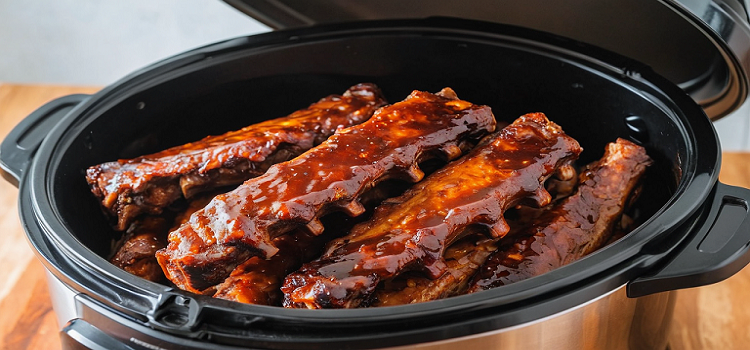As an Amazon Associate I earn from qualifying purchases.
Do You Put Water in the Pan When Cooking Ribs? A Comprehensive Guide
Cooking ribs can be a delightful experience, resulting in tender, flavorful meat that’s sure to impress family and friends. One common question that arises is whether to add water to the pan when cooking ribs. This guide will explore the various methods for cooking ribs, the role of water in the process, and tips for achieving the best results.

Understanding Ribs
Before diving into the cooking process, it’s important to understand the different types of ribs and the best cooking methods for each:
Types of Ribs
- Pork Ribs
- Baby Back Ribs: Tender and lean, these are smaller and cook faster.
- Spare Ribs: Larger, meatier, and generally have more fat, providing richer flavor.
- Beef Ribs
- Short Ribs: Thick, meaty cuts that require longer cooking times.
- Back Ribs: More bones than meat, often grilled or smoked.
Cooking Methods
Ribs can be cooked using various methods, including grilling, smoking, baking, and braising. The choice of method can affect whether or not to add water during the cooking process.
Do You Put Water in the Pan When Cooking Ribs?
General Practice
When cooking ribs, the inclusion of water in the pan can depend on your cooking method and desired outcome:
- Slow Cooking/Braising: If you’re braising ribs in the oven or a slow cooker, adding water or a flavorful liquid (like broth, cider, or barbecue sauce) helps to create steam, keeping the meat moist and tender throughout the cooking process.
- Baking/Roasting: If you’re baking ribs in the oven, adding water can help maintain moisture, especially if you’re covering the pan with foil. This method helps prevent the ribs from drying out during the cooking process.
- Grilling/Smoking: When grilling or smoking ribs, adding a water pan to the grill can help maintain humidity, but it’s typically not necessary to add water directly to the ribs themselves. Instead, consider using a marinade or basting with sauce to keep them moist.
Recommended Approach
- When Cooking in the Oven:
- Place the ribs in a roasting pan. You can add a small amount of water (about 1/4 to 1/2 inch) to the bottom of the pan to create steam, which will help keep the ribs moist.
- Cover the pan with aluminum foil for the first half of the cooking time. This traps steam, further preventing dryness.
- After the initial cooking period, remove the foil and allow the ribs to cook uncovered for the final portion to develop a nice crust and caramelization on the surface.
Cooking Methods Breakdown
Braising Method (Ideal for Tender Ribs)
- Ingredients: Ribs, seasoning, aromatics (onion, garlic), and liquid (water, broth, wine).
- Process:
- Season the ribs and brown them in a hot pan.
- Add aromatics and enough liquid to cover the ribs halfway.
- Cover and simmer on low heat or place in the oven at 300°F (150°C) for 2.5 to 3 hours until tender.
Baking Method (Perfect for Oven-Cooked Ribs)
- Ingredients: Ribs, dry rub, barbecue sauce, and water.
- Process:
- Preheat your oven to 300°F (150°C).
- Season the ribs with a dry rub and place them in a roasting pan.
- Add about 1/4 inch of water to the bottom of the pan and cover with foil.
- Bake for about 2.5 to 3 hours, removing the foil during the last 30 minutes to brush on barbecue sauce and caramelize.
Grilling/Smoking Method (For Flavorful Outdoor Cooking)
- Ingredients: Ribs, dry rub, and barbecue sauce.
- Process:
- Preheat your grill or smoker to 225°F to 250°F (107°C to 121°C).
- Season the ribs and place them on the grill. Consider placing a water pan in the grill to maintain humidity.
- Cook the ribs for about 3 to 4 hours, spraying with apple juice or broth every hour to keep them moist. Apply barbecue sauce during the last 30 minutes.
Tips for Cooking Ribs
- Choose the Right Cut: Select ribs based on your preference for meatiness and flavor. Spare ribs are more flavorful due to their higher fat content.
- Season Generously: Use a dry rub or marinade to enhance the flavor. Ingredients like paprika, garlic powder, onion powder, and brown sugar work well.
- Cook Low and Slow: For best results, cook ribs at a low temperature for an extended period. This method allows the collagen in the meat to break down, resulting in tender ribs.
- Rest the Ribs: After cooking, allow the ribs to rest for about 10-15 minutes before slicing. This helps redistribute the juices, ensuring juicy meat.
Conclusion
In summary, whether you put water in the pan when cooking ribs depends on the method you choose. For slow cooking and baking, adding water can help keep the ribs moist and tender, while grilling and smoking may benefit from humidity in the cooking environment without directly adding water to the ribs. By following the right techniques and tips, you can create perfectly cooked ribs that are flavorful and succulent. Enjoy your culinary adventure, and happy cooking!
As an Amazon Associate I earn from qualifying purchases.
Leave a Reply